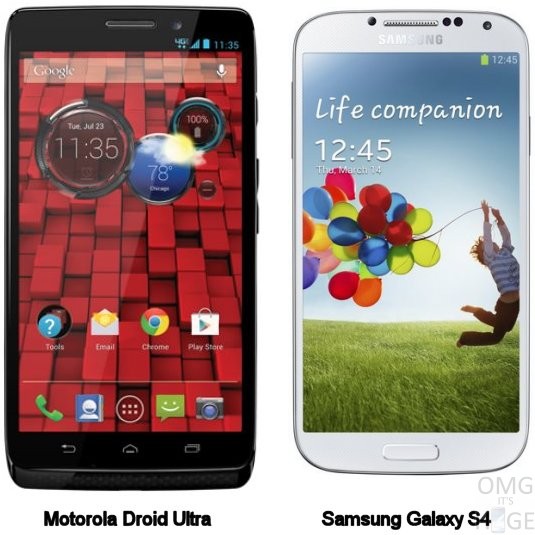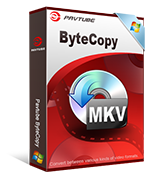Without a doubt, the Motorola DROID Ultra and Samsung Galaxy S4 are top tier smartphones from these respective companies, and carry the same $199.99 on-contract price from Verizon. But that is where most similarities end, as both devices have their own strong-points and short-comings, while trying to get your purchasing attention. The Galaxy S4 has been out for a couple of months now, and has a strong following, with an impressive 5” 1080×1920 display, 13MP camera, and quad-core processor. While the DROID Ultra has just been released, and continues the “DROID” branding, with Kevlar construction, 5” 720×1280 display, 10MP Clear Pixel camera, and uses the new Motorola X8 processor.
Now let’s take a closer look at these two smartphones and see how they stack-up next to each other.
Design
Both the Motorola DROID Ultra and Samsung Galaxy S4 are stylish in their own rite, though there are some differences. Most notably, the Galaxy S4 is slightly smaller in height and width, and has more curved edges, allowing it to fit more comfortably in your hand, while the DROID Ultra is the thinner of the two at only 7.18mm. The DROID Ultra is constructed out of Kevlar, making it more durable than the plastic polymer used by the Galaxy S4. Even though both devices have a glossy finish on the back, the DROID Ultra takes this to an even higher level, making it magnet for fingerprints and smudges.
Display
Since the DROID Ultra and Galaxy S4 both make use of a 5” Super AMOLED display, we are treated to nice saturated colors and excellent viewing angles. The key difference is that the display resolution on the Galaxy S4 is 1080×1920, while the DROID Ultra is 720×1280. Because of this, the Galaxy S4 has a higher pixels-per-inch count of 441, allowing for sharper text and images, while the DROID Ultra coming in at a lower 294 pixels-per-inch count. When looking at both phones next to each other, the difference is quite noticeable, and we are drawn instantly to the higher resolution display on the Galaxy S4.
Additionally, the Galaxy S4 comes with Samsung’s Air View feature, allowing it to track your finger movement as you hover over the display. But the DROID Ultra comes with Motorola’s new Active Display notifications, allowing only the center part of the display to turn on when checking the time, or if a new notification arrives, which is said to help conserve battery life.
Interface and Functionality
Android is all about choices, and that is clearly what we have here. Even though both devices are running Android 4.2.2 Jelly Bean, the interface looks different, as the Motorola DROID Ultra is pretty close to stock Android as possible with a simplistic approach, 5 homes screens and a basic widget selection. Though there are some Motorola exclusives included, such as the Touchless Control, which is voice recognition with the Google Now experience, Motorola Assist, Droid Zap for sharing images and videos to other nearby phones, Motorola Migrate to transfer setting from your old phone to your new phone, and Wireless Display.
Meanwhile, the TouchWiz Nature UX experience on the Galaxy S4 has its own features and functionality, such as the Air View and Air Gestures, Smart Screen with Smart Stay, Rotation, Pause, and Scroll, S Beam for sharing files, S Health tracking, and Screen Mirroring – not to mention a larger selection of desktop widgets.Needless to say, both offer a unique experience, depending on if you are looking for something close to stock Android, or a more customized user interface. You really have to weight your options here as to which one you prefer.
Processor and Memory
When it comes to sheer specs, the 1.9 GHz quad-core Snapdragon 600 processor with 2GB of RAM on the Samsung Galaxy S4 is a beast. But Motorola manages to compete well using its new X8 SoC Mobile Computing System with 2GB of RAM, which combines a modified 1.7 GHz dual-core Snapdragon S4 application processor, 400 MHz quad-core graphics processor, a natural language processing core, and a contextual computing core. When looking at the benchmark results, the Galaxy S4 does bring in higher results when running Quadrant and AnTuTu as those focus more on application performance, while the DROID Ultra does better with GLBenchmark and Vellamo, since those are more graphically intense. Still, in real-world use, both devices are plenty fast, and it’s difficult to notice much of a speed or performance difference between them.
| Quadrant Standard | AnTuTu | GLBenchmark 2.5 (Egypt HD) | Vellamo (HTML5 / Metal) |
|
| Motorola DROID Ultra | 8609 | 19384 | 5973 / 53 fps | 2455 / 768 |
| Samsung Galaxy S4 | 12078 | 24701 | 4437 / 39 fps | 1702 / 704 |
For storing your data, both smartphones come equipped with 16GB of internal memory, but the added bonus to the Galaxy S4 is that it comes sporting a microSD card slot, allowing you to add up to a 64GB memory card – something that the DROID Ultra can’t do.
Internet and Connectivity
Since the Motorola DROID Ultra is pretty close to stock Android, it only comes equipped with the Chrome web browser, while the Galaxy S4 comes with Chrome and Samsung’s own standard browser. It’s really personal preference here, as the web browsing experience on both devices are pretty much the same, and you can always install another 3rd party browser you want, such as Dolphin. But like we mentioned earlier, the 1080p display on the Galaxy S4 does allow for fine text and images to look sharper and less jagged, which is always a plus.
No surprise here, as Verizon’s 4G LTE network is also supported. When using the Speedtest.net app, both devices achieved around 20Mbps download speeds, but the DROID Ultra got up to 13Mbps for uploads, while the Galaxy S4 was less at 8Mbps for uploads. Since both smartphones are Global Roaming ready, they can be used in other countries with EDGE/GSM (850/900/1800/1900MHz), HSPA/UMTS (850/900/1900/2100MHz), supporting HSDPA 42.2 Mbps (Category 20) and HSUPA 5.76 Mbps speeds.
Naturally, there is also Wi-Fi 802.11 a/b/g/n (2.4GHz and 5GHz bands), Bluetooth 4.0 and NFC. Going a step further, we have video-out functionality with the aid of an MHL adapter on the Galaxy S4, plus an IR blaster that turns it into a universal remote.
Camera
The camera interface is another area where these two devices are vastly different. The Motorola DROID Ultra is more simplistic with only a few options for HDR, flash mode, tap-to-focus, slow motion, panorama, geo tag, shutter sound and quick capture. Meanwhile, the Samsung Galaxy S4 allows for a myriad of options, including 12 shooting modes, 13 visual effect, flash mode, resolution, burst shot, face detection, light metering, ISO, anti-shake, night detection, GPS tag, white balance, exposure, and even voice controls.
The Motorola DROID Ultra is using a new 10MP Clear Pixel sensor, which adds a clear pixel to the standard RGB, which is said to allow up to 75% more light to enter in, while the Samsung Galaxy S4 is equipped with a 13MP RGB sensor.
Our first round of images was captured outside on a sunny day, as this is always a good starting point. When viewing these on a PC, we could clearly make out some differences. First off, images from the DROID Ultra are so bright at times that they look to be overexposed. Not only that, but the colors appear dull and muted, and when zooming-in there is noticeable loss of detail. However, the outside images from the Galaxy S4 produced more realistic and vivid colors. We also noticed there was greater image detail, with images looking sharper, even when zooming-in.
For interior shots, there was less apparent differences, as both did OK as long as there was plenty of light in the room. But with the lighting lowered, there was even more noticeable grain in all of the images. When making use of the flash, the DROID Ultra produces a more green-hue, while the Galaxy S4 has a blue-hue to images.
For video recording, both devices capture at 1080p resolution at 30 frames-per-second. When watching the videos back on a PC, there was a noticeable exposure issues with the DROID Ultra, as the images would continually get brighter and darker, even when not moving the phone around. There also didn’t appear to any sort of continuous auto focus, as even taping the screen didn’t re-focus, but instead would capture a picture. Video from the Galaxy S4 looked marginally better, with more consistent exposure, and tap-to-focus working.
Multimedia
Out of the box, the DROID Ultra and Galaxy S4 are preloaded with the Google Play Music app – meaning, they’re both on the same playing field. As an alternative though, the TouchWiz music player on the Galaxy S4 is another option, as it employs some of the useful Air Gestures to fast-forward and reverse tracks. When listening to music through the rear speakers, the DROID Ultra does not only appear to be louder at the max volume, but also has a more fuller tone with better dynamic range than the Galaxy S4. But when connecting a pair of wired earbuds, or using a Bluetooth headset, music playback from both is nearly identical.
Playing HD video from either device isn’t a problem, with support for MPEG-4, H.264, DivX and Xvid. Videos look great on both 5” Super AMOLED screens, but again due to the higher resolution 1080p display on the Galaxy S4, videos do look sharper and clearer overall.
Call Quality
One area that Motorola always seems to out-perform the competition is with its call quality, and the same could be said here, as voices through the DROID Ultra sound more realistic and natural on both ends of the conversation. Calls on the Galaxy S4 aren’t bad by any means, but have a bit more of a “robotic” tone to them; though the earpiece volume can get much louder on the Galaxy S4 when it’s turned up all the way.
Signal reception is nearly identical between them, with -98dBm for voice and -101dBm for 4G LTE.
Battery
When it comes to battery capacity, the DROID Ultra is equipped with an internal 2130mAh non-removable battery, while the Galaxy S4 has a removable 2600mAh battery, meaning you can swap it out for another one – or even use a larger extended battery. While testing the continuous talk time, the DROID Ultra lasted for 13 hours straight, while the Galaxy S4 was a bit longer at 15 hours. But for mixed usage, both phones were able to last between 1.5-2 days, depending on the usage, but again you have the option of having a spare battery to use with the Galaxy S4. Another choice you should make note of is the Motorola DROID MAXX, which has a massive 3500mAh internal battery, allowing for even more talk and usage time.
Conclusion
Now we get to the hard part – which smartphone is better? It really depends on what you are looking for. If you want a device that is running close-to-stock Android simple and sweet, with the added bonus of the Motorola extras (active display, touchless controls, droid zap), with excellent call quality, and being constructed out Kevlar, than the Motorola DROID Ultra may be for you. But if you want a device that has a full 1080p display, true quad-core Snapdragon 600 processor, higher quality camera, microSD memory card slot, and replaceable battery, then you’ll probably be more content with the Samsung Galaxy S4. Since both come in at the same $199.99 price with a 2-year Verizon contract, we believe that the Galaxy S4 brings more to the table and has the the most bang-for-the-buck right now.











